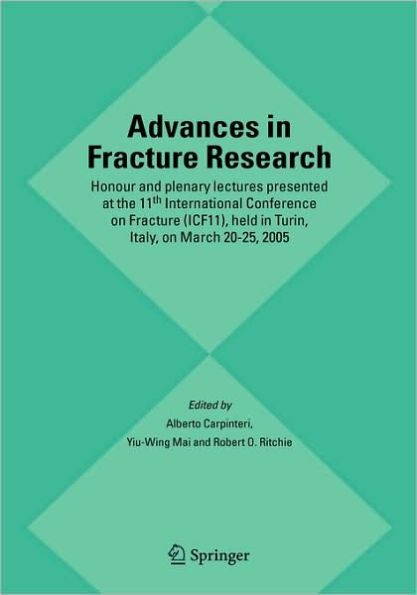Advances in Fracture Research: Honour and plenary lectures presented at the 11th International Conference on Fracture (ICF11), held in Turin, Italy, on March 20-25, 2005
Biological materials are bottom-up designed systems formed from billions of years of natural evolution. In the long course of Darwinian competition for survival, nature has evolved a huge variety of hierarchical and multifunctional systems from nucleic acids, proteins, cells, tissues, organs, organisms, animal communities to ecological systems. Multilevel hierarchy a rule of nature. The complexities of biology provide an opportunity to study the basic principles of hierarchical and multifunctional systems design, a subject of potential interest not only to biomedical and life sciences, but also to nanosciences and nanotechnology. Systematic studies of how hierarchical structures in biology are related to their functions and properties can lead to better understanding of the effects of aging, diseases and drugs on tissues and organs, and may help developing a scientific basis for tissue engineering to improve the standard of living. At the same time, such studies may also provide guidance on the dev- opment of novel nanostructured hierarchical materials via a bottom-up approach, i. e. by tailor-designing materials from atomic scale and up. Currently we barely have any theoretical basis on how to design a hierarchical material to achieve a part- ular set of macroscopic properties. The new effort aiming to understand the re- tionships between hierarchical structures in biology and their mechanical as well as other functions and properties may provide challenging and rewarding opportunities for mechanics in the 21st century.
1114776141
Advances in Fracture Research: Honour and plenary lectures presented at the 11th International Conference on Fracture (ICF11), held in Turin, Italy, on March 20-25, 2005
Biological materials are bottom-up designed systems formed from billions of years of natural evolution. In the long course of Darwinian competition for survival, nature has evolved a huge variety of hierarchical and multifunctional systems from nucleic acids, proteins, cells, tissues, organs, organisms, animal communities to ecological systems. Multilevel hierarchy a rule of nature. The complexities of biology provide an opportunity to study the basic principles of hierarchical and multifunctional systems design, a subject of potential interest not only to biomedical and life sciences, but also to nanosciences and nanotechnology. Systematic studies of how hierarchical structures in biology are related to their functions and properties can lead to better understanding of the effects of aging, diseases and drugs on tissues and organs, and may help developing a scientific basis for tissue engineering to improve the standard of living. At the same time, such studies may also provide guidance on the dev- opment of novel nanostructured hierarchical materials via a bottom-up approach, i. e. by tailor-designing materials from atomic scale and up. Currently we barely have any theoretical basis on how to design a hierarchical material to achieve a part- ular set of macroscopic properties. The new effort aiming to understand the re- tionships between hierarchical structures in biology and their mechanical as well as other functions and properties may provide challenging and rewarding opportunities for mechanics in the 21st century.
109.99
In Stock
5
1

Advances in Fracture Research: Honour and plenary lectures presented at the 11th International Conference on Fracture (ICF11), held in Turin, Italy, on March 20-25, 2005
262
Advances in Fracture Research: Honour and plenary lectures presented at the 11th International Conference on Fracture (ICF11), held in Turin, Italy, on March 20-25, 2005
262
109.99
In Stock

Product Details
| ISBN-13: | 9781402046261 |
|---|---|
| Publisher: | Springer Netherlands |
| Publication date: | 09/14/2006 |
| Edition description: | 2006 |
| Pages: | 262 |
| Product dimensions: | 8.27(w) x 11.69(h) x 0.02(d) |
From the B&N Reads Blog
